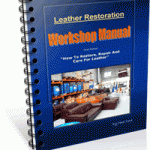Visit CollisionBlast.com/CarFabric for fabrics and vinyls for car interior.
By John Burgess I
The best advice you can give anyone who has decided to take on the project of restoring a vintage car themselves is to begin by restoring their interior first. Your vintage car interior is an aspect of the project where you can do all or most of the work yourself and at home, but you should make every effort to take your time, and to give as much attention to detail as you possibly can while doing this part of your restoration.
You should begin this project by removing the seats and the carpeting. If you’re lucky the seat upholstery will be salvageable, but more often than not this is not the case. Re-doing seat upholstery requires a great deal of work and patience. Moreover, attention should be given to using the same materials as were originally in the car. As an example, this may have been vinyl or fabric which were the most common materials used in the past.
If there is any stitching required and especially where tough materials need to be repaired, you’ll need to use an industrial sewing machine, as your standard machine will not get the job done. This is a job where you may want to seriously consider hiring a professional to do the work for you. If you check on the prices for an industrial sewing machine, you’ll discover that this is something that is cost prohibitive and not worth investing in.
Typically, for all other aspects of upholstery work there are very few tools that are required and it is more than worth purchasing those that you do need at the onset of the project. You’ll be able to kill two birds with one stone because it is very likely that the fabric will have to be replaced and this can be purchased at most fabric stores, along with the tools that you are going to need to complete the project.
Before you begin working on the upholstery, it might be a good idea to invest some time in cleaning and removing any rust that may be present on the metal which supports the seat. Additionally you’ll also want to replace any worn out springs.
If you’re upholstering with vinyl this is something that you may want to tackle yourself. Once you’ve completed the previously mentioned tasks you can now begin to replace the padding and the vinyl.
Ordinarily, this is normally done with small nails that are covered up by cording. The most important thing when doing this task is that you need to insure that the material you are using is taut over the frame before you attach it to the seat.
After completing your seats you may want to remove the existing carpeting and check for rust. In the event that you find that your floor boards are rusted, this can be remedied by using a sandblaster to do the removal process. If you run into bad luck you may discover that your floor boards are rotted through, and if that is the case you’ll have to completely replace them.
Next, your last step is to replace the carpet itself, and the good news is that this is really not difficult to do and you can do this by using carpet remnants. These can be acquired at your local carpet store and at a minimal cost.
Finally, its time to take the dashboard apart and you should not be surprised if you discover that the electrical wiring is worn out. As for replacement parts your best chance is to look online or look for guidance from members of your local car club who will be more than willing to offer you guidance and help with this part of your interior restoration.
Most products that you will need for the care of your newly restored interior can also be found online or at your local auto parts store.
John Burgess I has been involved in vintage car restoration for over two decades, and enjoys sharing the knowledge he has acquired about this amazing pastime with others. For more information about the vintage car interior you can visit his newest website at http://www.vintagecarrestorationinfo.com.
Article Source: http://EzineArticles.com/?expert=John_Burgess_I
http://EzineArticles.com/?Vintage-Car-Interior—Restoration-Tips&id=6581999
HOW TO REPAIR LEATHER
 How To Repair & Restore Leather Upholstery, Saving You A Fortune In Replacement Costs! Leather Restoration Expert with over 28 years experience reveals tricks of the trade. Now, you can use the step-by-step method to create results you’ll be proud of.
How To Repair & Restore Leather Upholstery, Saving You A Fortune In Replacement Costs! Leather Restoration Expert with over 28 years experience reveals tricks of the trade. Now, you can use the step-by-step method to create results you’ll be proud of.
